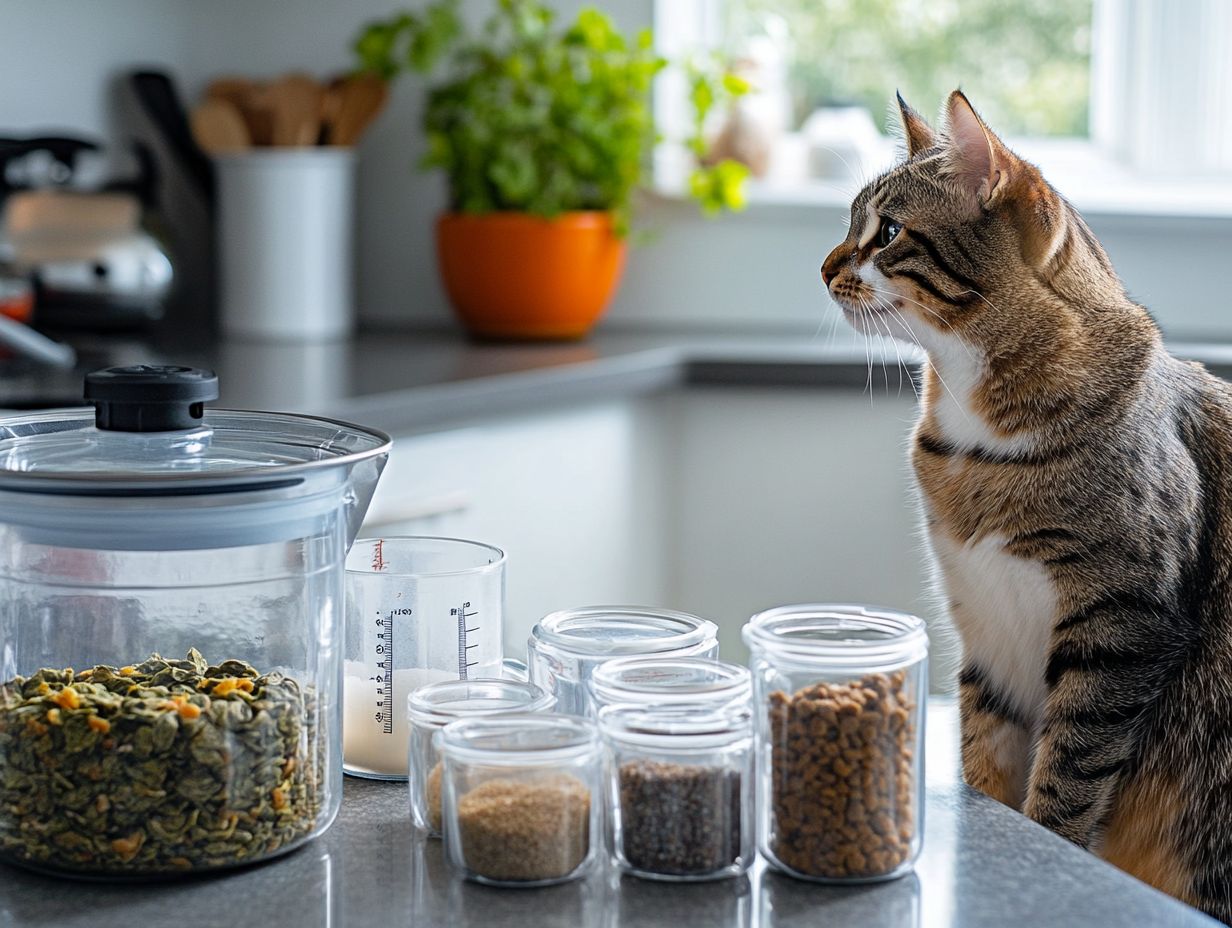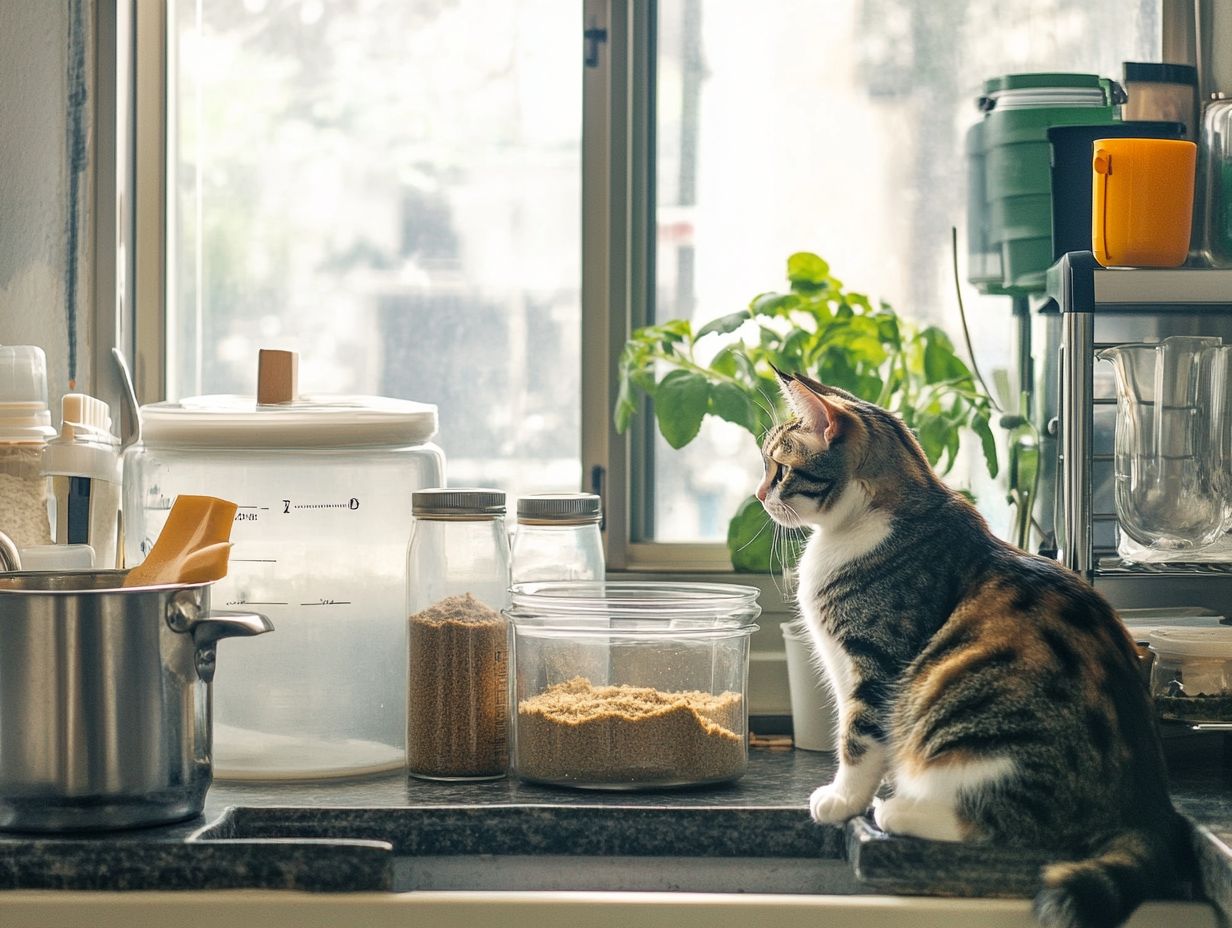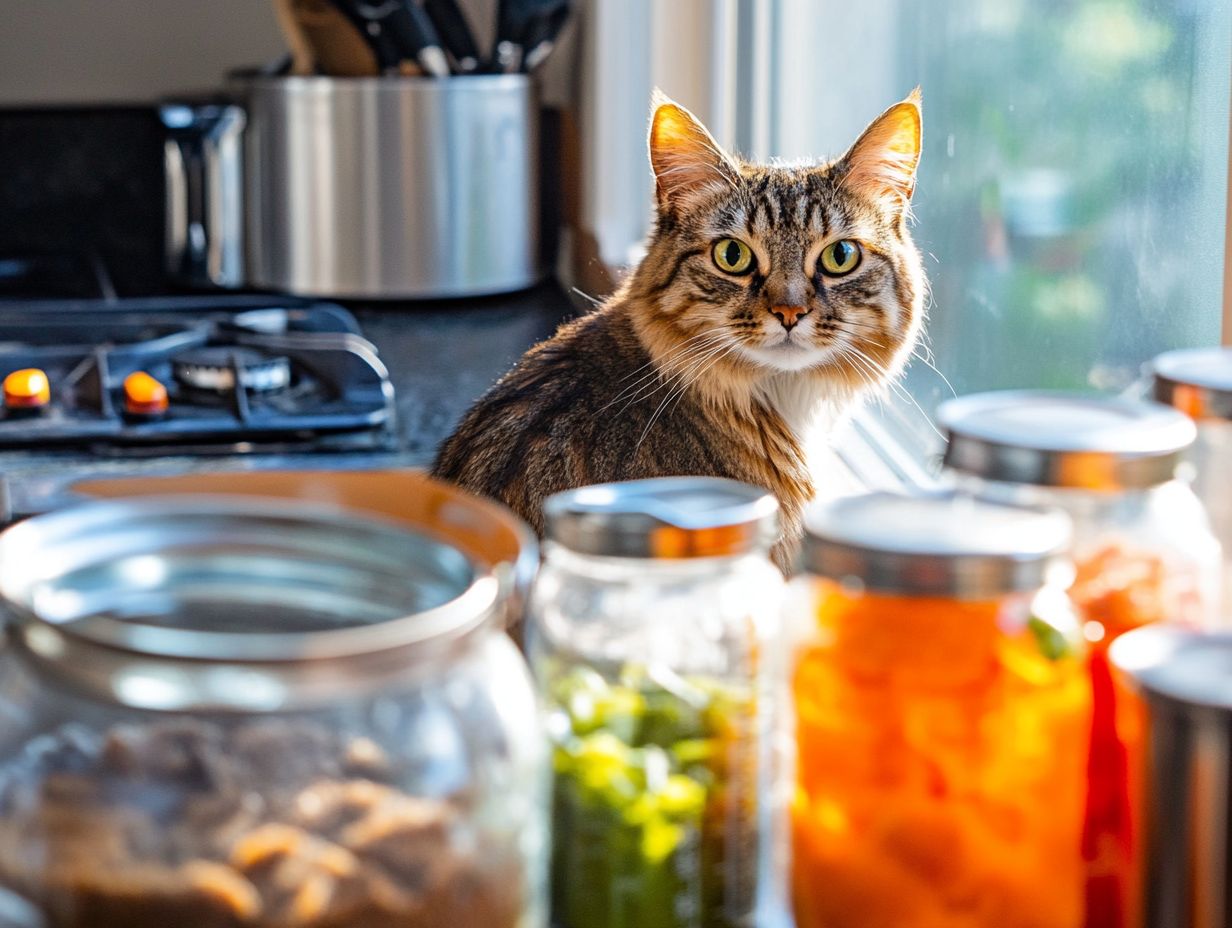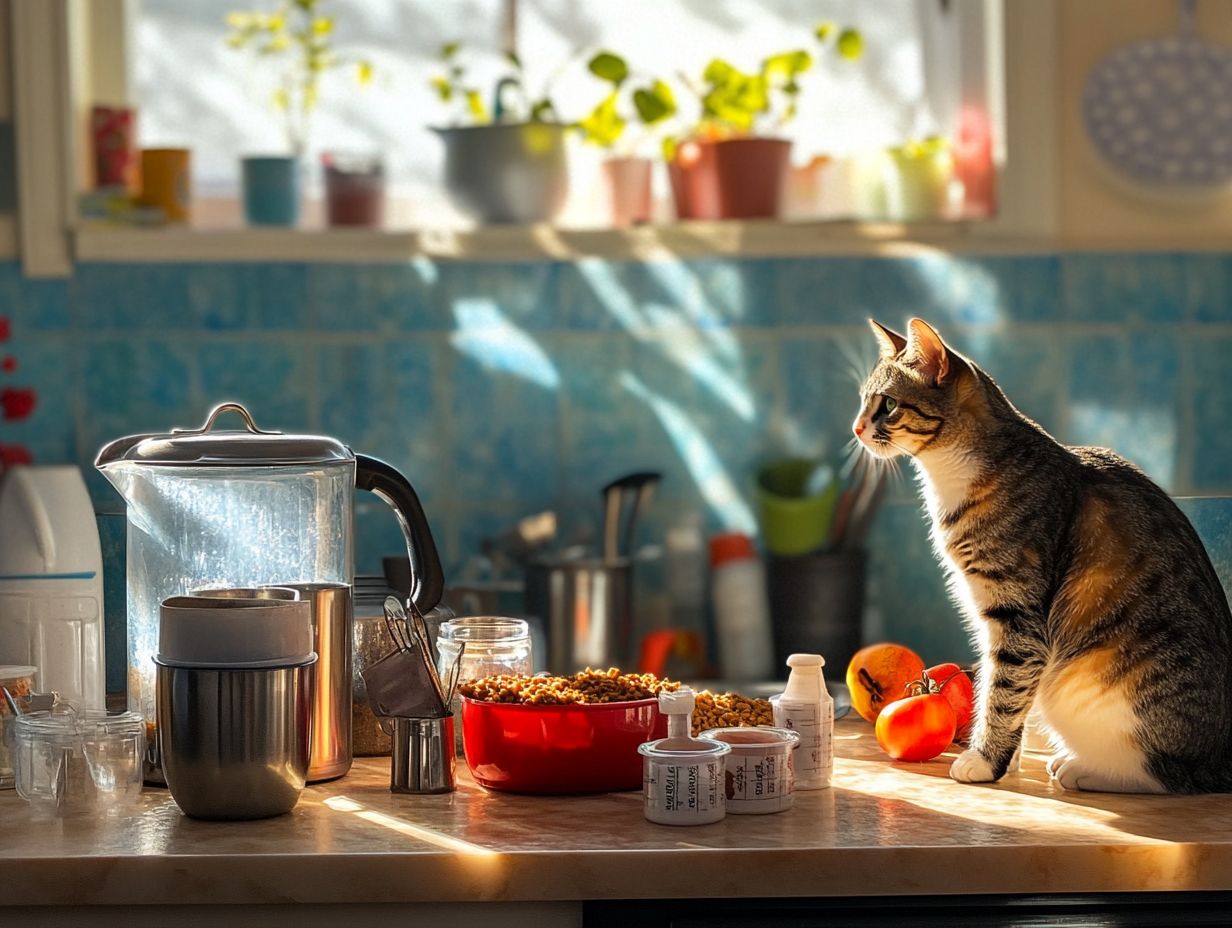Are you curious about freeze-dried cat food and whether it’s the right choice for your obligate carnivore? Understanding your cat’s nutritional needs for animal-source proteins can guide your decision.
This innovative pet food option is gaining popularity for good reason, offering digestible ingredients that meet AAFCO standards.
Explore what freeze-dried cat food is and the numerous benefits it offers, from retaining essential nutrients to being convenient for travel while minimizing health risks like Salmonella and E.coli. While freeze-dried food can be convenient, it’s crucial to consult with a veterinarian to ensure it meets your cat’s specific health needs. Additionally, while freeze-dried food retains nutrients, some formulations may pose risks similar to raw diets, so thorough veterinary consultation is advised.
We’ll guide you through the preparation process with easy steps and share tips for incorporating it into your cat’s diet. Store freeze-dried cat food in a cool, dry place and always check for any signs of spoilage before serving, such as off smells or discoloration.
Keep reading to discover a hassle-free way to nourish your pet, ensuring their well-being with vet-approved diets and safe handling practices!
Key Takeaways:

What Is Freeze-Dried Cat Food?
Freeze-dried cat food is a specialized type of pet food that undergoes a preservation process designed to maintain its nutritional value while offering convenience for cat owners. The freeze-drying process removes moisture from the food, effectively preventing bacterial contamination and extending its shelf life. This makes it suitable for a range of feeding habits.
Additionally, it is particularly beneficial for cats with sensitive stomachs or specific dietary restrictions, ensuring they receive balanced nutrition that meets AAFCO standards. Consider the unique nutritional requirements for different life stages—kittens, senior cats, and pregnant or nursing cats—when selecting freeze-dried options.
Why Choose Freeze-Dried Cat Food?
Freeze-dried cat food offers several benefits, including a protein-rich diet that matches the quality of non-dried options. This is especially appealing to cat owners who are concerned about health risks associated with traditional cat food methods, such as those related to high-pressure processing, foodborne infections, and toxoplasmosis.
Freeze-dried cat food preserves the natural flavors and nutrients of its ingredients while ensuring that cats’ dietary standards are met. Many brands are developing freeze-dried cat food that meets high standards for nutritional quality.
What Are the Benefits of Freeze-Dried Cat Food?
The benefits of freeze-dried cat food are numerous, providing a comprehensive solution for cat owners seeking balanced nutrition tailored to their pets’ specific needs. This type of food addresses a wide range of feline health issues, including weight management, dietary restrictions, and the convenience and safety of feeding practices, all while keeping in mind cost considerations.
As cat owners become increasingly aware of the health consequences associated with improper nutrition, freeze-dried cat food ensures that each meal meets dietary requirements and aligns with veterinarian recommendations and AAFCO standards.
1. Retains Nutritional Value
One of the primary advantages of freeze-dried cat food is its ability to retain nutritional value, ensuring that your cat receives all the essential nutrients in every meal. The freeze-drying process preserves the unique nutritional profile of the ingredients, particularly protein sources, which allows for optimal nutrient absorption and digestibility.
This innovative method effectively locks in vitamins and minerals that are often lost during traditional cooking processes, contributing to a more balanced diet. By minimizing exposure to heat and moisture, freeze-drying enhances the availability of nutrients that are crucial for a feline’s overall health.
High-quality diets rich in essential amino acids and omega fatty acids support various aspects of health, from a lustrous coat to robust immune function. Ultimately, providing your pet with freeze-dried options prioritizes their nutritional needs, leading to improved overall health and quality of life. Veterinary advice can further enhance their diet.
2. Convenient and Easy to Store
One of the main advantages of freeze-dried cat food is its convenience and ease of storage, making it an ideal choice for busy cat parents. With low moisture content, freeze-dried cat food does not require refrigeration and can be stored without the risk of spoilage, ensuring safe handling and food safety throughout its shelf life. It aligns well with raw diets yet mitigates risks associated with them. However, it is crucial to ensure that freeze-dried cat food contains adequate animal-source proteins and essential nutrients, as cats are obligate carnivores.
Its lightweight nature also facilitates easy transportation, allowing cat parents to maintain their feeding routines even while traveling. This aligns well with modern feeding habits, as the food can be easily portioned and prepared on demand. Using airtight containers can prevent exposure to air and moisture, which helps preserve the food’s quality and nutritional value. Always monitor for signs of spoilage or contamination when storing freeze-dried products.
Additionally, keeping portions in pre-packaged snack-sized bags can aid in preventing overfeeding and make it easier to adhere to a consistent feeding schedule, ultimately reducing waste. This combination of convenience and practicality is essential for individuals with busy lifestyles. It is also important to follow specific feeding guidelines based on different life stages (kittens, adults, seniors) to ensure comprehensive nutritional advice.
3. Ideal for Traveling

The ideal type of cat food for traveling is freeze-dried cat food, as it helps cat owners maintain their pets’ feeding routines on the go. This option is lightweight, compact, and easy to pack, minimizing the risk of spills or spoilage while ensuring that cats receive a high-quality diet during travel. Preparedness for dietary changes during travel is key. However, it’s essential to keep in mind that not all freeze-dried foods meet AAFCO standards; always check for the AAFCO statement on the packaging to ensure compliance.
Freeze-dried cat food requires minimal preparation, making it suitable for feeding cats while camping in the woods or staying in hotels. Pet owners only need to add water to rehydrate the food before serving, ensuring their cats enjoy healthy and nutritious meals that meet their dietary needs. Veterinary consultation is advised before making any dietary changes, especially for cats with specific health conditions or dietary needs.
To facilitate feeding, serving sizes can be pre-portioned into travel-friendly containers, helping pet owners adhere to their cats’ feeding schedules. If the travel destination lacks sufficient water, bringing a portable bowl and a supply of fresh water is essential for keeping cats hydrated, which is crucial for their health while traveling. Over-reliance on freeze-dried food without incorporating a balanced diet that includes moisture can pose hydration risks for feline health.
4. Suitable for Cats with Food Allergies
Freeze-dried cat food is an excellent choice for cats with food allergies or sensitivities, as it typically features a limited number of high-quality ingredients that comply with AAFCO (Association of American Feed Control Officials) standards. This allows cat owners to provide their pets with food that meets specific health requirements while minimizing the risk of triggering allergic reactions. It is crucial to monitor cats for allergies or sensitivities when transitioning to freeze-dried food, watching for symptoms to ensure their health. Veterinary consultation is advised for managing these health issues.
Many freeze-dried varieties, for instance, are free from grains, soy, or dairy, making them particularly suitable for cats with sensitivities. To compare brands effectively, cat owners should carefully examine ingredient lists, seeking those with a single protein source, such as chicken or fish, which can help isolate and manage allergies. Trusted cat brands often highlight their unique nutritional profiles on food labels. However, potential nutritional deficiencies could arise from relying solely on freeze-dried diets, particularly if they are not balanced or lack variety.
Veterinarian recommendations can also assist cat owners in identifying trusted brands known for their quality and safety practices.
How to Prepare Freeze-Dried Cat Food?
Preparing freeze-dried cat food is a simple process that enables pet owners to provide their cats with essential nutrition without the need for elaborate cooking methods.
This preparation method allows cat owners to adhere to proper feeding guidelines and safe handling practices while also ensuring the appropriate moisture content for optimal digestibility, reducing the risk of digestive problems.
Step 1: Gather Ingredients and Supplies
The first step in preparing freeze-dried cat food is to gather all necessary ingredients and supplies while adhering to food labels and recommended serving sizes. This preparation lays the groundwork for a safe and nutritious meal that meets your cat’s specific dietary needs and supports their overall well-being.
Essential supplies include high-quality freeze-dried proteins, which can range from chicken to fish, as well as any additional nutrients such as vegetables or supplements. It is crucial to carefully check food labels to ensure the absence of fillers, artificial additives, and allergens, as these can compromise the overall quality of the meal. Consulting a veterinary nurse or Dr. Amy Fox from Cornell University can provide further insights.
By choosing high-quality freeze-dried cat food, you help preserve the nutritional integrity, providing your feline friend with optimal vitamins and minerals as part of a balanced diet that includes animal-source proteins, reflecting their obligate carnivore nature. By thoughtfully selecting each component, cat owners can confidently meet their pets’ preparation and nutritional requirements, further enhancing their cat nutrition. It is also important to follow feeding guidelines from the AAFCO to ensure the food meets nutritional standards.
Step 2: Measure and Mix Freeze-Dried Food with Water
After preparing your ingredients, mix the appropriate amount of freeze-dried cat food with water to achieve the desired moisture content, tailoring it according to the individual product’s instructions. This step is crucial for ensuring that your cat receives a meal that is both palatable and digestible, supporting their protein needs.
As a general guideline, it is recommended to use one part freeze-dried food to two parts water for proper hydration, but this should be adapted based on the specific product instructions. For instance, if you use one cup of freeze-dried food, you should mix it with two cups of warm water.
Once you add the water over the freeze-dried nuggets, allow the mixture to sit for 10 to 15 minutes, stirring occasionally. This process not only enhances the flavor but also ensures food safety by properly reconstituting the ingredients. One key aspect to monitor is the texture; it should be soft yet firm. Achieving the right texture is vital for ensuring your cat enjoys the food and that it is safe for consumption. Improper rehydration can lead to spoilage, so be vigilant for signs such as off odors or discoloration.
Step 3: Let the Food Rehydrate
Allowing freeze-dried cat food to rehydrate is a crucial step in the preparation process, as it enhances the food’s texture and flavor while preserving its nutrient profile for optimal nutrition for your cat. The rehydration process typically takes between 5 to 10 minutes, depending on the brand and specific formulation of the food.
Although this preparation step may seem minor, insufficient time for proper hydration can significantly reduce digestibility, leading to lower nutrient absorption in cats. When the food is allowed to soften, it becomes easier for cats to chew and eat, resulting in a more enjoyable overall eating experience. Always consult with your veterinarian before making dietary changes, particularly for cats with special dietary needs or health conditions.
As with all aspects of feed preparation, it is essential for cat parents to follow the specific guidelines for rehydration times and methods provided by the manufacturer, as this directly impacts their pets’ health and happiness. Adhering to these instructions ensures that your feline family member receives all the benefits of their meal.
Step 4: Serve to Your Cat

Once the freeze-dried cat food has rehydrated, it is served to the cat as a proper meal, tailored to its feeding habits and preferences. Ensuring the food is at room temperature is essential for maximum enjoyment and food safety.
To enhance the meal experience, serve the food in a clean, shallow dish that accentuates its color, as cats are often attracted to bright colors and are more likely to eat immediately upon seeing their meal. Proper food handling is crucial; remember to wash your hands before and after serving and store any uneaten food safely. Leftover food should be sealed in an airtight container and stored in the refrigerator to maintain freshness and prevent spoilage.
As you introduce the new cat food, carefully monitor your cat’s reaction to ensure it adjusts well, considering any food allergies, and watch for any signs of discomfort or changes in appetite. If you observe any adverse reactions, consult with your veterinarian for guidance.
Tips for Feeding Freeze-Dried Cat Food
Understanding feeding tips and practices promotes cats’ well-being and ensures a smooth transition to this unique nutritional option.
Feeding your cat freeze-dried food can be a seamless experience with the right tips and practices, ensuring a smooth transition to this nutritious option. It is crucial for cat owners to implement gradual dietary changes to prevent digestive issues and minimize health risks associated with sudden shifts in nutrition. Additionally, keep fresh water available at all times, as hydration is critical for cats, especially when feeding dry food.
1. Gradually Introduce to Your Cat’s Diet
To minimize the likelihood of digestive issues in your pet, it is essential to introduce freeze-dried cat food gradually. The best approach is to start by mixing small amounts of freeze-dried food with your cat’s regular diet, gradually increasing the proportion over the course of a few days to allow their digestive system to adjust.
- Begin with a ratio of 10% freeze-dried food to 90% of their regular kibble or wet food for the first three days. Consult with your veterinarian before making any significant dietary changes, especially for cats with underlying health conditions.
- If your cat shows no signs of digestive distress during this period, you can then gradually increase the mix to 25% freeze-dried food over the next few days.
- Following that, aim for a 50-50 mix in the week after, while monitoring for any signs of discomfort, such as vomiting or diarrhea.
- By the end of two weeks, you can transition your cat to a diet consisting entirely of freeze-dried food, provided it meets their digestive needs and offers a balanced nutrient intake according to AAFCO standards.
2. Monitor Your Cat’s Weight and Adjust Portions Accordingly
Regularly monitoring your cat’s weight is crucial when feeding freeze-dried cat food, as portion sizes may need to be adjusted over time to prevent excessive weight gain or loss. Frequent weigh-ins can help ensure that your cat’s nutritional needs are met without overfeeding or underfeeding. Regular veterinary check-ups are also important for tailored dietary recommendations, especially for cats with specific health concerns like kidney disease or diabetes.
If your cat has a higher activity level (e.g., they play often and engage in vigorous activity), they may require more calories, while a less active cat (e.g., one that sleeps a lot and engages in minimal play) may need smaller portion sizes to avoid weight gain. Engaging in regular discussions with your veterinarian can provide valuable guidance on any necessary dietary changes, especially for certain medical conditions.
Considering all these factors will help cat owners effectively monitor their pet’s weight and ensure that feeding practices align with proper health management.
3. Store Freeze-Dried Cat Food Properly
Safe storage practices for freeze-dried cat food are essential to ensure the food’s safety and nutritional integrity. The food should be kept in a cool, dry place, and the packaging must always be sealed tightly to prevent moisture from compromising its quality. Always check the expiration date on freeze-dried food packaging before use, as feeding expired products can pose health risks.
If possible, store the food in an airtight container, as this protects it from exposure to air and humidity. Although freeze-dried foods have long shelf lives, it remains important to regularly check for signs of spoilage, such as unusual smells or textures.
Additionally, using desiccants to absorb any excess moisture can help maintain maximum freshness. By following these food safety practices, pet owners can effectively preserve the shelf life of freeze-dried cat food.
Frequently Asked Questions
What is freeze-dried cat food and why is it a popular choice for pet owners?

Freeze-dried cat food supports cat nutrition and provides balanced nutrition for sensitive stomachs. Freeze-dried foods can be easier to digest and less likely to cause allergic reactions.
Freeze-dried cat food is a type of pet food that has been dehydrated through a process of freezing and then removing all moisture. It is a popular choice for pet owners because it offers numerous benefits, such as a longer shelf life, convenience, and a healthier alternative to traditional kibble.
How do I prepare freeze-dried cat food for my feline friend?
To prepare freeze-dried cat food, simply follow these steps: 1) Measure out the recommended serving size for your cat. 2) Add warm water or broth (avoid using broth with onions or garlic, as these can be toxic to cats) to rehydrate the food. 3) Mix well and let it sit for a few minutes. 4) Serve and watch your cat enjoy their delicious meal!
Can I mix freeze-dried cat food with other types of food?
Yes, you can mix freeze-dried cat food with other types of food, such as wet or dry food. This can add variety to your cat’s diet and provide them with a balance of nutrients.
How should I store freeze-dried cat food?
It is important to store freeze-dried cat food in a cool, dry place. Make sure to seal the bag tightly after each use to maintain freshness. If you have any leftover rehydrated food, it should be kept refrigerated and discarded after 24 hours.
Is freeze-dried cat food suitable for all cats?
Freeze-dried cat food is suitable for most cats, including kittens, senior cats, and nursing mothers, but it is always best to consult with your veterinarian before making any changes to your cat’s diet. Some cats with specific health conditions may require a special diet and may not be able to tolerate freeze-dried food.
Are there any potential drawbacks to feeding my cat freeze-dried food?
While freeze-dried cat food offers many benefits, it is important to note that it may be more expensive than traditional kibble. Additionally, the rehydration process may take some time and may not be ideal for pet owners who are always on-the-go. Improper rehydration can lead to inadequate hydration, which can result in health issues for your cat.